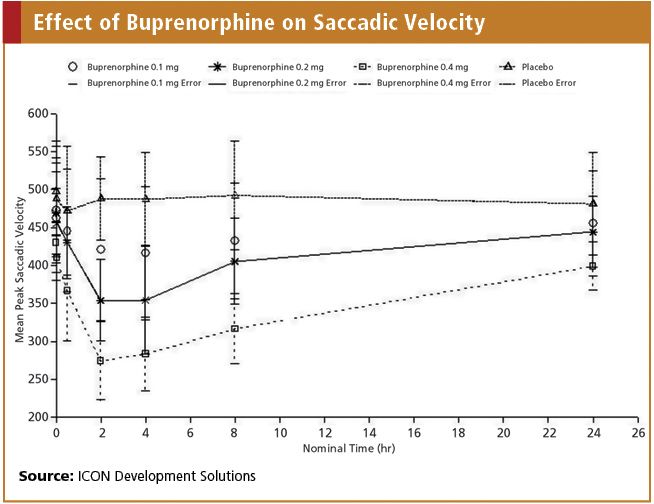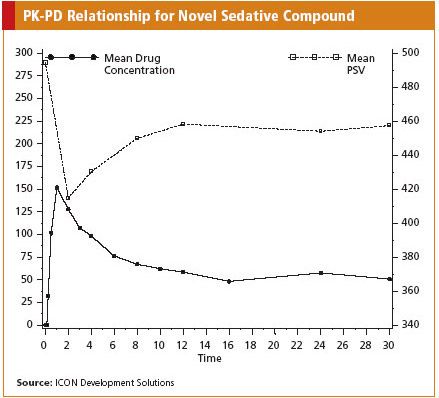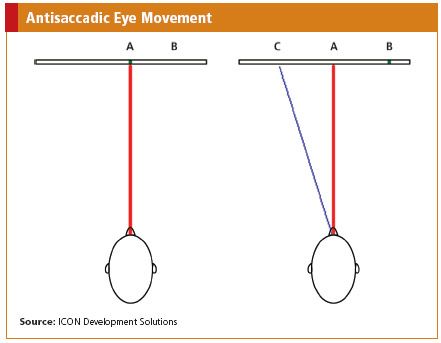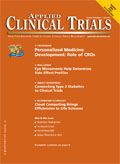Eyes Play a Focal Role in Research
Applied Clinical Trials
Two unique techniques help characterize pharmacodynamic drug effects in healthy subjects.
Over the last 20 years there has been a significant change in the approach that is taken to the early stages of clinical development. The initial studies of a molecule in man are no longer focused purely on safety, tolerability, and PK but are layering in techniques to better understand and characterize a molecule in terms of putative efficacy, both wanted and undesired side effects, time course of pharmacodynamic effects, and competitive performance to existing therapies.

The drive for the change has come from the industry itself which has been faced with rising R&D expenditures and a high fail rate of molecules in expensive patient trials. The pressure has grown to reduce development time lines, decrease overall development costs and make go/no-go decisions on compounds at an earlier stage.
At the forefront of this change has been the inclusion of often simple physiological measures into the first in man trials that can be used to provide some of this pivotal information. To illustrate the use of these techniques this article will explore how two simple techniques involving measurements from the eyes, saccadic eye movements, and pupillometry, are being applied to investigate the side-effect profile of compounds, better understand the mechanisms involved in the pathophysiology of CNS disease states and demonstrate target engagement of drugs.
Technique one: saccadic eye movements
A saccadic eye movement, or saccade, occurs when a human changes their direction of gaze from one point to another (Figure 1). The decision to initiate a saccade is under voluntary control, however, once the saccade is initiated the speed that the eye moves is completely involuntary with no central CNS influence.

Saccadic velocity has been shown to be adversely effected by compounds that cause sedation. A number of studies have reported that ethanol will induce a decrease in saccadic velocity at very low doses where the subjects are unable to qualitatively self-report feelings of sedation.1 Decreases have similarly been shown when subjects have received compounds that induce symptoms of sedation such as benzodiazepines and opiates.
Measurement of saccadic eye movements under controlled laboratory conditions therefore presents an opportunity to characterize the sedative effects of any compound. To understand and interpret the clinical relevance of any changes in this parameter it is essential that researchers measuring saccades benchmark the technique against a wide range of compounds known to induce sedation that work via contrasting pharmacological mechanisms.
Measurement of saccadic eye movements can be performed in a number of different ways. The most common include using electrooculogram (EOG) electrodes positioned at the upper and lower canthus of the eye to detect muscle movement, and the use of infrared detectors focused on the eye using a device known as a saccadometer. Subjects are asked to focus on a sequence of lights, which may either be presented on a light bar or projected using lasers in front of them, and to follow the lights with their eyes as quickly and accurately as possible. Common to both the EOG and infrared approach in any commercially available system is a software package that can analyze the incoming signal from the eye and automatically derive a range of outcome measures including peak saccadic velocity and the latency of saccadic initiation.
As part of our validation of saccadic technique, we investigated the effects of an increasing dose of buprenorphine on the velocity of saccades in 16 healthy male volunteers (Figure 2). A crossover design was employed so that all volunteers received all treatments in a pseudo-random order. A one week washout was allowed between treatments. Volunteers receiving placebo showed little variation in velocity of saccades over the 24-hour period following treatment administration, however buprenorphine appeared to induce a decrease in saccadic velocity peaking around two hours post dose. Magnitude of deficit of response was demonstrated to be dose dependent.

Figure 3 presents a plot of concentration vs. response for a novel compound that induced significant sedation. It was possible to model a strong PK-PD relationship for this outcome measure. This modeling of concentration against effect can provide pivotal information on target concentration for future studies and help in the selection of dose and dosing regimens for future studies. The study clearly indicated that at doses above 100 ng/mL significant sedation was occurring in the single ascending dose study, an undesirable profile for a potential drug. However, we were able to demonstrate in the multiple ascending dose study that when these concentrations were built up over the course of a few days, no impairment in saccadic velocity was reported. Taken together these results helped guide the dosing regimen for the subsequent patient trials.

The two examples illustrate how the pharmaceutical industry is applying saccadic eye movements both in individual targeted studies focusing specifically on pharmacodynamic parameters and also as part of first-in-man studies where the PD data is a secondary objective of the trial. In both cases saccadic eye movement is a fast, highly sensitive and non-invasive measure. Combined with the involuntary nature of the response, this makes it a powerful, objective marker of sedation that can easily be included in early clinical trials to screen for sedation.
In addition to playing a role in profiling a compound in healthy volunteers, the unique properties of saccadic eye movements can be used to better understand disease states. The study of eye movements as a trait marker for schizophrenia has been documented for over 40 years. The most marked effects have been seen when the saccade task described above is adapted to become an antisaccade task (Figure 4). In the antisaccade task subjects fixate on a central light. This light goes off and is replaced by a light on the periphery that is to the left or right. Subjects are instructed not to look at the new light but instead to fixate on an equivalent position on the opposite side of the central light (i.e., if the light is 10 degrees left of center they should look 10 degrees right of center). This task tests the ability to restrain the natural impulse to look at the light and requires significant frontal lobe/executive control. It is a difficult task with even healthy controls looking in the wrong direction around 20% of the time.

Schizophrenic patients have been shown to demonstrate significantly greater numbers of errors on this task compared to healthy controls with error rates of greater than 50%. Interestingly, studies in first-degree relatives of patients with schizophrenia have also been conducted. Error rates in relatives appear to split into two distinct groups with some performing like healthy volunteers and others having high error rates like their patient relatives. This suggests that the outcome measure could be of relevance to familial trait characteristics in schizophrenia.2
As the antisaccade task requires significant frontal lobe function, the test has been used to investigate the hypothesis that the ability of atypical neuroleptics to improve the negative symptoms of schizophrenia is due to enhanced frontal lobe function. Eighteen patients stably maintained on depot neuroleptic medication were co-administered the 5-HT antagonist cyproheptidine, known to improve frontal lobe function. Significant improvement in antisaccade error rate was detected, supporting the role of the frontal lobe in controlling this function.3
Technique two: pupillometry
Measurement of pupil diameter has been shown to be a sensitive and objective marker of autonomic activation4 and a validated marker of drug activity on the autonomic nervous system.5
In this test, subjects sit in front of an infrared camera under standard low-light conditions. The camera is focussed on the pupil. Measurement of initial pupil diameter is recorded directly and the pupillary constriction response (latency, amplitude, and duration) to a flash of light is also measured.
Opiates are known to cause constriction of the pupil and therefore this technique can be used to detect and quantify opiate response.
Figure 5 illustrates the effects of two gold-standard opiates, morphine and tramadol. Morphine induces a rapid and significant decrease in pupil diameter, reducing it by approximately 40% within the first hour of dosing. This effect is still ongoing by five hours post-dose although it is beginning to recover by this stage. The effect of tramadol is a much smaller and delayed response with no significant decrease in pupil size seen until two to four hours post-dose. The effect on pupil diameter is controlled by action on the mu-opioid receptor. Morphine has high affinity for this receptor and hence a strong, immediate effect is seen. In contrast, tramadol has low affinity for this receptor, though some of its metabolites do have greater affinity, and hence a delayed change is observed.

As with saccadic eye movements it is possible to use the technique for modeling concentration vs. dynamic effect. PK-PD modeling allows for a greater characterization of the effects of the novel opiate, including the calculation of concentration required to produce maximal effect. This can be invaluable information for designing an appropriate patient study.
Pupillometry can also be applied in patient trials to provide added-value information and in better characterizing the pathophysiology of a wide range of disease states. One area where the technique has been applied longitudinally to monitor disease state is with neuropathy associated with diabetes. A number of studies have shown that pupil reaction to ocular light stimulation deteriorates as the condition progresses, both in terms of pupil diameter, reflex amplitude and constriction velocity.6 Pupillometry can therefore be used to track improvements to the progression of the disease made following pharmacological intervention.
Pupillometry is also used extensively in research into sleep disorders where significant changes in pupillary response have been detected in conditions such as sleep deprivation and hypersomnia and therefore this method allows evaluation of potential therapies in these and other related disorders such as sleep apnea. Pupillometry can also play a role in migraine research. Studies have been carried out using pupillometry to measure changes in pupillary light reflex in the period following migraine headache. Decreases in both the amplitude and speed of the constriction response in these patients indicated the potential involvement of the parasympathetic nerves supplying the eye in migraine headache. This enabled a better understanding of the pathophysiology of this disease and led to the development of targeted drug therapies.7
Due to the alterations in pupillary reaction seen with opiates and other illegal drugs there is a potential for the use of pupillometry as a non-invasive physiological method of detecting drug-related impairment. Both pupil diameter and pupillary constriction response are affected by a range of drugs including marijuana, stimulants, tranquilizers, and opiates such as cocaine and heroin suggesting that pupillometry could provide a more effective and less costly alternative to urinalysis-based drug testing.
Summary
The application of specific techniques to better characterize the pharmacodynamic effects of a drug are becoming commonplace in early phase trials. Key to the success of these tools is to select the most appropriate technique that is well-validated and has proven effects with compounds of similar target indication or class.
Data from these trials can be pivotal in guiding the dose selection for future patient studies and in identifying unwanted pharmacodynamic effects of a drug at an early stage. This illustrates the positive contribution that pharmacodynamic measurements can make in accelerating a cost-effective early clinical development program.
John Connell* is VP Pharmacodynamics, e-mail: [email protected] and Jane Baxendale is Manager Clinical Pharmacodynamics at ICON Development Solutions, Skelton House, Manchester Science Park, Manchester M15 6SH, UK.
*To whom all correspondence should be addressed.
References
1. L. Holdstock and H. de Wit, "Ethanol Impairs Saccadic and Smooth Pursuit Eye Movements without Producing Self-Reports of Sedation," Alcoholism: Clinical and Experimental Research, 23 (4) 664–672 (1999).
2. T. J. Crawford, T. Sharma, B. K. Puri, R. M. Murray, D. M. Berridge, and S. W. Lewis, "Saccadic Eye Movements in Families Multiply Affected with Schizophrenia: the Maudsley Family Study," American Journal of Psychiatry, 155 (12) 1703-1710 (1998).
3. I. B Chaudhry, S. D Soni, J. S. E Hellewell, and J. F. W Deakin, "Effects of the 5HT Antagonist Cyproheptadine on Neuropsychological Function in Chronic Schizophrenia," Schizophrenia Research, 53 (1) 17-24 (2002).
4. J. Grünberger, L. Linzmayer, M. Grünberger, and B. Saletu, "Pupillometry in Clinical Psychophysiological Diagnostics: Methodology and Proposals for Application in Psychiatry," Israeli Journal of Psychiatry and Related Sciences, 29 (2) 100-113 (1992).
5. V. Koudas, A. Nikolaou, E. Hourdaki, S. G. Giakoumaki, P. Roussos, and P. Bitsios, "Comparison of Ketanserin, Buspirone, and Propranolol on Arousal, Pupil Size, and Autonomic Function in Healthy Volunteers," Psychopharmacology, 205 (1) 1-9 (2009).
6. K. Thamotharampillai, A. K. F. Chan, B. Bennetts, M. E. Craig, J. Cusumano, M. Silink, P. J. Oates, and K. C. Donaghue, "Decline in Neurophysiological Function after Seven Years in an Adolescent Diabetic Cohort and the Role of Aldose Reductase Gene Polymorphisms," Diabetes Care, 29 (9) 2053-2057 (2006).
7. V. Mylius, H. J. Braune, and K. Schepelmann, "Dysfunction of the Pupillary Light Reflex Following Migraine Headache," Clinical Autonomic Research, 13 (1) 16-21 (2003).

Improving Relationships and Diversifying the Site Selection Process
April 17th 2025In this episode of the Applied Clinical Trials Podcast, Liz Beatty, co-founder and chief strategy officer, Inato, discusses a number of topics around site engagement including community-based sites, the role of technology in improving site/sponsor relationships, how increased operational costs are impacting the industry, and more.